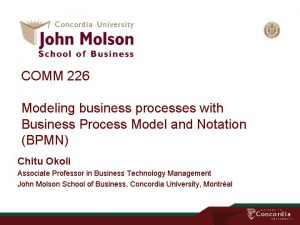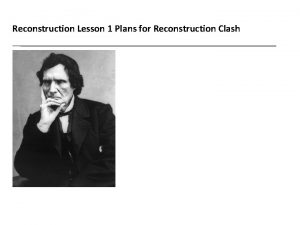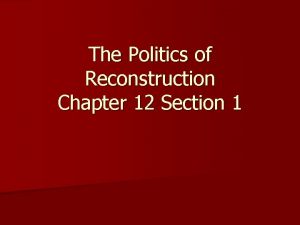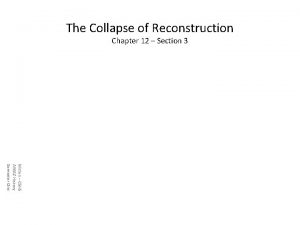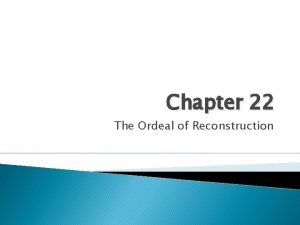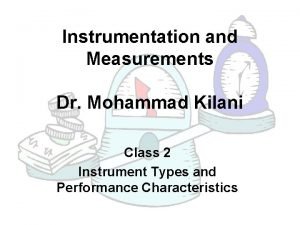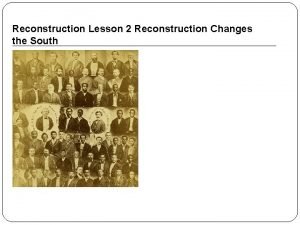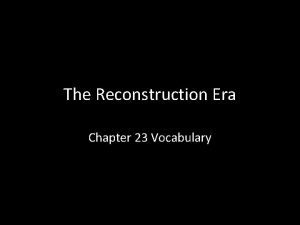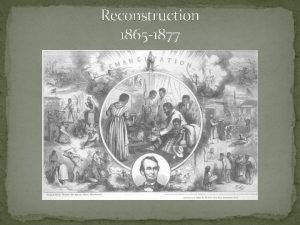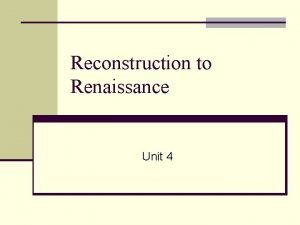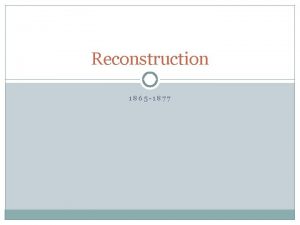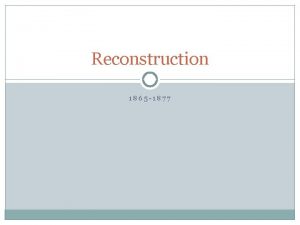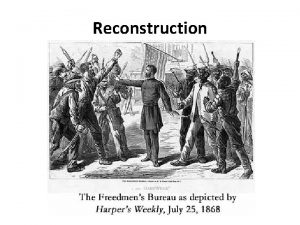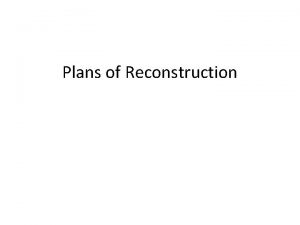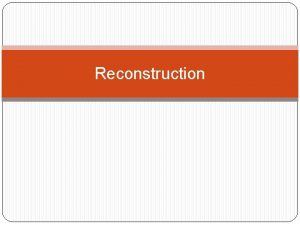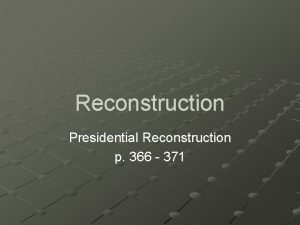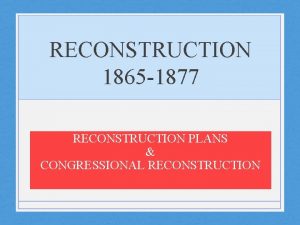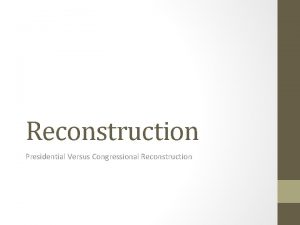Lesson 10 Type Reconstruction 226 Chapter 22 Lesson


![Type substitutions Language: [Bool, Nat] with type variables A type substitution is a finite Type substitutions Language: [Bool, Nat] with type variables A type substitution is a finite](https://slidetodoc.com/presentation_image_h2/dbae52315c61ff12fabf3282a05d0d8f/image-3.jpg)
![Type substitutions Language: [Bool, Nat] with type variables A type substitution is a finite Type substitutions Language: [Bool, Nat] with type variables A type substitution is a finite](https://slidetodoc.com/presentation_image_h2/dbae52315c61ff12fabf3282a05d0d8f/image-4.jpg)







![Unification algorithm unify C = if C = then [ ] else let {S Unification algorithm unify C = if C = then [ ] else let {S](https://slidetodoc.com/presentation_image_h2/dbae52315c61ff12fabf3282a05d0d8f/image-12.jpg)




![Macro-like let rule |- t 1: T 1 |- [x => t 1]t 2: Macro-like let rule |- t 1: T 1 |- [x => t 1]t 2:](https://slidetodoc.com/presentation_image_h2/dbae52315c61ff12fabf3282a05d0d8f/image-17.jpg)







- Slides: 24

Lesson 10 Type Reconstruction 2/26 Chapter 22 Lesson 10: Type Reconstruction

Type Reconstruction • • • substitutions typing with constraint sets (type equations) unification: solving constraint sets principlal types let polymorphism Lesson 10: Type Reconstruction 2
![Type substitutions Language Bool Nat with type variables A type substitution is a finite Type substitutions Language: [Bool, Nat] with type variables A type substitution is a finite](https://slidetodoc.com/presentation_image_h2/dbae52315c61ff12fabf3282a05d0d8f/image-3.jpg)
Type substitutions Language: [Bool, Nat] with type variables A type substitution is a finite mapping from type variables to types. = [X => Nat -> Nat, Y => Bool, Z => X -> Nat] Type substitutions can be applied to types: T (X -> Z) = (Nat -> Nat) -> (X -> Nat) This extends pointwise to contexts: Lesson 10: Type Reconstruction 3
![Type substitutions Language Bool Nat with type variables A type substitution is a finite Type substitutions Language: [Bool, Nat] with type variables A type substitution is a finite](https://slidetodoc.com/presentation_image_h2/dbae52315c61ff12fabf3282a05d0d8f/image-4.jpg)
Type substitutions Language: [Bool, Nat] with type variables A type substitution is a finite mapping from type variables to types. = [X => Nat -> Nat, Y => Bool, Z => X -> Nat] Type substitutions can be applied to types: T (X -> Z) = (Nat -> Nat) -> (X -> Nat) This extends pointwise to contexts: Composition of substitutions o (X) = ( X) if X dom = X otherwise Lesson 10: Type Reconstruction 4

Substitutions and typing Thm: If |- t: T, then |- t: T for any type subst. . Prf: induction on type derivation for |- t: T. Lesson 10: Type Reconstruction 5

"Solving" typing problems Given and t, we can ask: 1. For every , does there exist a T s. t. |- t: T? 2. Does there exist a and a T s. t. |- t: T? 3. Question 1 leads to polymorphism, where T = T' and |- t: T'. The type variables are "quantified". Question 2 is the basis for type reconstuction: we think of the type variables as unknowns to be solved for. Defn: A solution for ( , t) is a pair ( , T) s. t. |- t: T. Lesson 10: Type Reconstruction 6

Example: solutions of a typing problem ( , x: X. y: Y. z: Z. (x z) (y z)) has solutions [X => Nat -> Bool -> Nat, Y => Nat -> Bool, Z => Nat] [X => X 1 -> X 2 -> X 3, Y => X 1 -> X 2, Z => X 1] Lesson 10: Type Reconstruction 7

Constraints A constraint set C is a set of equations between types. C = {Si = Ti | i 1, . . , n}. A substitution unifies (or satisfies) a constraint set C if Si = Ti for every equation Si = Ti in C. A constraint typing relation |- t: T | C where is a set of "fresh" type variables used in the constraint set C. This relation (or judgement) is defined by a set of inference rules. Lesson 10: Type Reconstruction 8

Constraint inference rules Inference rule for application |- t 1: T 1 | C 1 1 |- t 2: T 2 | C 2 2 1 2 = 1 FV(T 2) = 2 FV(T 1) = X 1, 2, t 1, t 2, T 1, T 2, C 1, C 2, C = C 1 C 2 {T 1 = T 2 -> X} = 1 2 {X} |- t 1 t 2: X | C Lesson 10: Type Reconstruction 9

Constraint solutions Defn: Suppose |- t: S | C . A solution for ( , t, S, C) is a pair ( , T) s. t. satisfies C and T = S. Thm: [Soundness of Constraint Typing] Suppose |- t: S | C X. If ( , T) is a solution for ( , t, S, C) then it is also a solution for ( , t), i. e. |- t: T. Thm: [Completeness of Constraint Typing] Suppose |- t: S | C . If ( , T) is a solution for ( , t) then there is a solution ( ', T) for ( , t, S, C) s. t. ' = . Cor: Suppose |- t: S | C . There is a soln for ( , t) iff there is a solution for ( , t, S, C). Lesson 10: Type Reconstruction 10

Unification Defn: < ' if ' = o for some . Defn: A principle unifier (most general unifier) for a constraint set C is a substitution that satisfies C s. t. < ' for any other ' that satifies C. Lesson 10: Type Reconstruction 11
![Unification algorithm unify C if C then else let S Unification algorithm unify C = if C = then [ ] else let {S](https://slidetodoc.com/presentation_image_h2/dbae52315c61ff12fabf3282a05d0d8f/image-12.jpg)
Unification algorithm unify C = if C = then [ ] else let {S = T} C' = C in if S = T then unify(C') else if S = X and X FV(T) then unify([X => T]C') o [X => T] else if T = X and X FV(S) then unify([X => S]C') o [X => S] else if S = S 1 -> S 2 and T = T 1 -> T 2 then unify(C' {S 1 = T 1, S 2 = T 2}) else fail Thm: unify always terminates, and either fails or returns the principal unifier if a unifier exists. Lesson 10: Type Reconstruction 12

Principal Types Defn: A principal solution for ( , t, S, C) is a solution ( , T) s. t. for any other solution ( ', T') we gave < '. Thm: [Principal Types] If ( , t, S, C) has a solution, then it has a principal one. The unify algorithm can be used to determine whether ( , t, S, C) has a solution, and if so it calculates a principal one. Lesson 10: Type Reconstruction 13

Implicit Annotations We can extend the syntax to allow lambda abstractions without type annotations: x. t. The corresponding type constraint rule supplies a fresh type variable as an implicit annotation. X , x: X |- t 1: T | C , |- x: X. t 1: X -> T | C ( {X}) Lesson 10: Type Reconstruction (CT-Abs. Inf) 14

Let Polymorphism let double = f: Nat -> Nat. x: Nat. f(f x) in double ( x: Nat. succ x) 2 let double = f: Bool -> Bool. x: Bool. f(f x) in double ( x: not x) false An attempt at a generic double: let double = f: X -> X. x: X. f(f x) in let a = double ( x: Nat. succ x) 2 in let b = double ( x: not x) false ==> X -> X = Nat -> Nat = Bool -> Bool Lesson 10: Type Reconstruction 15

Macro-like let rule let double = f: X -> X. x: X. f(f x) in let a = double ( x: Nat. succ x) 2 in let b = double ( x: not x) false could be typed as: let a = ( f: X -> X. x: X. f(f x)) ( x: Nat. succ x) 2 in let b = ( f: X' -> X'. x: X'. f(f x)) ( x: not x) false or, using implicit type annotations: let a = ( f. x. f(f x)) ( x: Nat. succ x) 2 in let b = ( f. x. f(f x)) ( x: not x) false Lesson 10: Type Reconstruction 16
![Macrolike let rule t 1 T 1 x t 1t 2 Macro-like let rule |- t 1: T 1 |- [x => t 1]t 2:](https://slidetodoc.com/presentation_image_h2/dbae52315c61ff12fabf3282a05d0d8f/image-17.jpg)
Macro-like let rule |- t 1: T 1 |- [x => t 1]t 2: T 2 |- let x = t 1 in t 2: T 2 (T-Let. Poly) The substitution can create multiple independent copies of t 1, each of which can be typed independently (assuming implicit annotations, which introduce separate type variables for each copy). Lesson 10: Type Reconstruction 17

Type schemes Add quantified type schemes: T : : = X | Bool | Nat | T -> T P : : = T | X. P Contexts become finite mappings from term variables to type schemes: : : = | , x : P Examples of type schemes: Nat, X -> Nat, X. Y. X -> Y -> X Lesson 10: Type Reconstruction 18

let-polymorphism rules |- t 1: T 1 , x : . T 1 |- t 2: T 2 |- let x = t 1 in t 2: T 2 (T-Let. Poly) where ' are the type variables free in T 1 but not free in , x : . T |- x: [ => ']T (T-Poly. Inst) where ' is a set of fresh type variables Lesson 10: Type Reconstruction 19

let-polymorphism example double : X. (X -> X) -> X let double = f. x. f(f x) in let a = double ( x: Nat. succ x) 2 in let b = double ( x: not x) false in (a, b) (Y -> Y) -> Y (Z -> Z) -> Z Then unification yields [Y => Nat, Z => Bool]. Lesson 10: Type Reconstruction 20

let-polymorphism and references Let ref, !, and : = be polymorphic functions with types ref : X. X -> Ref(X) ! : X. Ref(X) -> X : = : X. Ref(X) *X -> Unit let r = ref( x. x) r : X. Ref(X -> X) in let a = r : = ( x: Nat. succ x) in let b = !r false in () Ref(Nat -> Nat) Ref(Bool -> Bool) We've managed to apply ( x: Nat. succ x) to false! Lesson 10: Type Reconstruction 21

The value restriction We correct this unsoundness by only allowing polymorphic generalization at let declarations if the expression is a value. This is called the value restriction. let r = ref( x. x) r : Ref(X -> X) in let a = r : = ( x: Nat. succ x) in let b = !r false in () Ref(Nat -> Nat) [X => Nat] Ref(Nat -> Nat) Now we get a type error in " !r false ". Lesson 10: Type Reconstruction 22

Let polymorphism with recursive values Another problem comes when we add recursive value definitions. let rec f = x. t in. . . is typed as though it were written let f = fix( f. x. t) in. . . where fix : X. (X -> X) -> X except that the type of the outer f can be generalized. Note that the inner f is -bound, not let bound, so it cannot be polymorphic within the body t. Lesson 10: Type Reconstruction 23

Polymorphic Recursion What can we do about recursive function definitions where the function is polymorphic and is used polymorphically in the body of it's definition? (This is called polymorphic recursion. ) let rec f = x. (f true; f 3; x) Have to use a fancier form of type reconstruction: the iterative Mycroft-Milner algorithm. Lesson 10: Type Reconstruction 24
 226 curepipe
226 curepipe Linea 1503
Linea 1503 Al quran muka surat 226
Al quran muka surat 226 Psy 226
Psy 226 Cmpe 226
Cmpe 226 Comm 226 quiz 1
Comm 226 quiz 1 Comm 226
Comm 226 Lesson 1 planning reconstruction
Lesson 1 planning reconstruction The politics of reconstruction chapter 12 section 1
The politics of reconstruction chapter 12 section 1 The collapse of reconstruction chapter 12 section 3
The collapse of reconstruction chapter 12 section 3 Reconstruction and its effects
Reconstruction and its effects Ordeal chapter 22
Ordeal chapter 22 Ordeal chapter 22
Ordeal chapter 22 Chapter 2 reconstruction america's unfinished revolution
Chapter 2 reconstruction america's unfinished revolution Chapter 6 civil war and reconstruction
Chapter 6 civil war and reconstruction Chapter 12 reconstruction and its effects
Chapter 12 reconstruction and its effects Is hyper v type 1 or type 2
Is hyper v type 1 or type 2 Order of recruitment of muscle fiber types
Order of recruitment of muscle fiber types Pregnancy test keeps saying error
Pregnancy test keeps saying error Type 1 error vs type 2 error example
Type 1 error vs type 2 error example Rock cycle
Rock cycle Narrow band theory in sport
Narrow band theory in sport Mbti breakdown
Mbti breakdown Myotonic dystrophy.
Myotonic dystrophy. Deflection type instruments
Deflection type instruments
